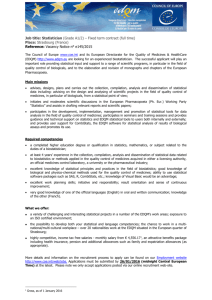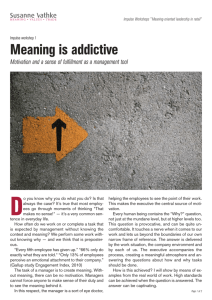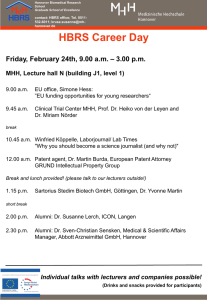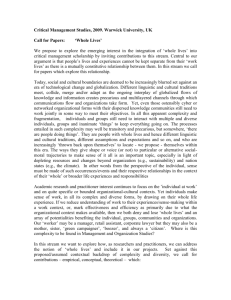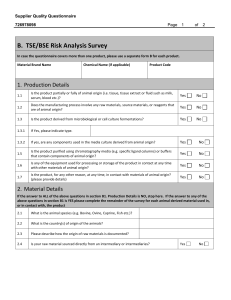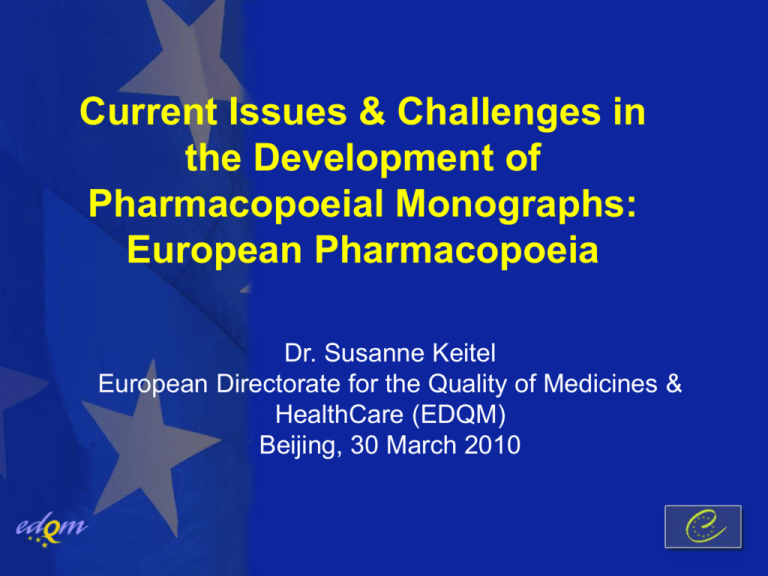
Current Issues & Challenges in
the Development of
Pharmacopoeial Monographs:
European Pharmacopoeia
Dr. Susanne Keitel
European Directorate for the Quality of Medicines &
HealthCare (EDQM)
Beijing, 30 March 2010
The Council of Europe
– Founded in 1949
– Development of
European common
and democratic
principles
– 47 member countries
– Headquarters in
Strasbourg
Core values :
Protection of human rights (European Convention on
Human Rights &Fundamental Freedoms), pluralist
democracy & the rule of law
Dr. Susanne Keitel, 30/03/10 ©2010 EDQM, Council of Europe, All rights reserved
2
The European Union
Dr. Susanne Keitel, 30/03/10 ©2010 EDQM, Council of Europe, All rights reserved
4
EDQM - Short History
1964:
– Convention on the Elaboration of a European
Pharmacopoeia signed by 8 Member States
1992:
– 1st co-operation contract with the EU Commission on
the Biological Standardisation Programme
1994:
– European Community signs the Convention
– CEP – Implementation of the “Certification of
Suitability scheme”
– Official Medicines Control Laboratory (OMCL) –
Creation of the Network
Dr. Susanne Keitel, 30/03/10 ©2010 EDQM, Council of Europe, All rights reserved
5
Short History
Change of name: the Secretariat of
the European Pharmacopoeia
becomes the European Department
(and later “Directorate”) for the
Quality of Medicines
(and later “& HealthCare”)…
Dr. Susanne Keitel, 30/03/10 ©2010 EDQM, Council of Europe, All rights reserved
6
Progressive Transfer of
Activities
2007 – Blood Transfusion and Organ
Transplantation
2008 – Pharmaceuticals and
Pharmaceutical Care (general
pharmaceutical activities)
2009 – Cosmetics and Food Packaging
Dr. Susanne Keitel, 30/03/10 ©2010 EDQM, Council of Europe, All rights reserved
7
Ph.Eur.+ Eur. Observers
Dr. Susanne Keitel, 30/03/10 ©2010 EDQM, Council of Europe, All rights reserved
8
In the World
Dr. Susanne Keitel, 30/03/10 ©2010 EDQM, Council of Europe, All rights reserved
9
Content
1.Is There a Need for A
Pharmacopoeia? – Scope
2.Challenges of Globalisation – What
Can Pharmacopoeias Contribute?
3.Prospective Harmonisation – a
Way to Speed-up the Process?
Dr. Susanne Keitel, 30/03/10 ©2010 EDQM, Council of Europe, All rights reserved
10
The role of Pharmacopoeias is to
Guarantee the Quality of Medicines
• Harmonised specifications for
substances of different origins
(worldwide trade)
• Transparent monographs (impurity
profile)
• Specifications and valid analytical
working methods
• Common Reference Substances
Dr. Susanne Keitel, 30/03/10 ©2010 EDQM, Council of Europe, All rights reserved
11
Why a Monograph ?
• A public standard, an independent
evaluation
• One single quality for everybody
• Protection of public health via a
standard which represents one known
quality
• Simplify the compilation of dossiers for
industry and as a result of this the
evaluation of marketing authorisation
Dr. Susanne Keitel, 30/03/10 ©2010 EDQM, Council of Europe, All rights reserved
12
What Type of Monograph ?
• All active ingredientes and excipients of
general interest
• Priority: therapeutic interest, number of
patients treated, number of countries
where the product is approved,
mandatory quality
Dr. Susanne Keitel, 30/03/10 ©2010 EDQM, Council of Europe, All rights reserved
13
Fields Covered
• Active substances (organic, inorganic)
• Excipients
• Substances of biological and biotechnological
origin (insulin, somatropin…)
• Vegetable drugs and preparations, essential
and fatty oils
• Radiopharmaceuticals
• Vaccines, sera (human, veterinary), blood
derivatives
• Homoeopathic preparations
• ….
Dr. Susanne Keitel, 30/03/10 ©2010 EDQM, Council of Europe, All rights reserved
14
The Users
• Pharmaceutical industry
• Pharmaceutical industry suppliers
• Regulatory authorities (medicines
agencies)
• OMCLs
• Others…
Dr. Susanne Keitel, 30/03/10 ©2010 EDQM, Council of Europe, All rights reserved
15
The European Pharmacopoeia is…
• A public health instrument
• A source of standardisation
• A reference and a model for quality in the field of
medicines
• Harmonisation of work for 36 European countries
free movement
• Competition of industry at « eye level » as they are
bound by the same health standards
• Activities based on an international Convention under
the aegis of the Council of Europe
Dr. Susanne Keitel, 30/03/10 ©2010 EDQM, Council of Europe, All rights reserved
16
Content
1.Is There a Need for A
Pharmacopoeia? – Scope
2.Challenges of Globalisation – What
Can Pharmacopoeias Contribute?
3.Prospective Harmonisation – a
Way to Speed-up the Process?
Dr. Susanne Keitel, 30/03/10 ©2010 EDQM, Council of Europe, All rights reserved
17
Impact of Globalisation
• New routes of API synthesis may result in
different impurity profiles
• Cost pressure in public health systems
may cause frequent changes in suppliers
• A globally acting industry needs
harmonised regulatory requirements
• ….
Dr. Susanne Keitel, 30/03/10 ©2010 EDQM, Council of Europe, All rights reserved
18
General Principles in Elaborating
Monographs
• SAFETY FIRST!
• Products of proven safety
• Products evaluated and approved by
competent authorities of Member States
• Impurity profiles for existing, approved
synthetic routes
• Robust, validated analytical methods based
on collaborative laboratory testing
Dr. Susanne Keitel, 30/03/10 ©2010 EDQM, Council of Europe, All rights reserved
19
Directive 2003/63/EC
“The monographs of the European
Pharmacopoeia shall be applicable to all
substances, preparations and
pharmaceutical forms appearing in it. In
respect of other substances, each
Member State may require observance of
its own national pharmacopoeia.
Dr. Susanne Keitel, 30/03/10 ©2010 EDQM, Council of Europe, All rights reserved
20
Directive 2003/63/EC
However, where a material in the
European Pharmacopoeia … has been
prepared by a method liable to leave
impurities not controlled in the
pharmacopoeia monograph, these
impurities and their maximum tolerance
limits must be declared and a suitable test
procedure must be described.”
Directive 2003/63/EC, 3.2 Content: basic principles
and requirements
Dr. Susanne Keitel, 30/03/10 ©2010 EDQM, Council of Europe, All rights reserved
21
Need to Stay Up-Dated
• To serve its purpose, the
pharmacopoeia has to stay up-dated
with changes in medical practice and
technological developments, for
example:
– The significant growth of biotechnologically
manufactured API
– The growing importance of ethnic medicines, e.g.
Traditional Chinese Medicines
Dr. Susanne Keitel, 30/03/10 ©2010 EDQM, Council of Europe, All rights reserved
22
Need to Stay Up-Dated
• To follow developments in the pharmaceutical
industry (change in paradigm introduced by
the ICH guidelines Q8, Q9, Q10), while taking
into consideration the specific needs of the
globally acting industry and small and
medium-sized enterprises,
BUT
• The protection of public health stays FIRST
PRIORITY!
Dr. Susanne Keitel, 30/03/10 ©2010 EDQM, Council of Europe, All rights reserved
23
Content
1.Is There a Need for A
Pharmacopoeia? – Scope
2.Challenges of Globalisation – What
Can Pharmacopoeias Contribute?
3.Prospective Harmonisation – a
Way to Speed-up the Process?
Dr. Susanne Keitel, 30/03/10 ©2010 EDQM, Council of Europe, All rights reserved
24
Background
• International Harmonisation of general
monographs and excipients within PDG
ongoing, but not on APIs
• Harmonisation of long-existing texts has
proven to be
– difficult due to different approaches / traditions
– slow to take account of stakeholders’ needs in the
different regions who need to adapt
Dr. Susanne Keitel, 30/03/10 ©2010 EDQM, Council of Europe, All rights reserved
25
Pilot Project Ph.Eur. and USP
• Common initiative of 2 manufacturers,
Ph.Eur. and USP in 2008
• JP has been informed and will observe
process and outcome
• Main idea: harmonise prospectively
based on EDQM “P4” procedure for
substances still under patent
Dr. Susanne Keitel, 30/03/10 ©2010 EDQM, Council of Europe, All rights reserved
26
Pilot Procedure
1. Submission of identical data packages
to EDQM and USP
2. After paper review, a common list of
questions is sent to the manufacturer
3. EDQM reviews the replies and
prepares a draft to a joint EDQMP4/USP expert group
4. The draft is verified in parallel in
laboratories of EDQM, USP, national
authorities (OMCLs) or FDA.
Dr. Susanne Keitel, 30/03/10 ©2010 EDQM, Council of Europe, All rights reserved
27
Pilot Procedure (2)
5. The manufacturer may test in parallel
6. All labs reports are exchanged
7. The P4 Rapporteur co-ordinates the
discussion on the reports and
proposes potential changes of the first
draft to the manufacturer
8. A consensus draft is published in
Pharmeuropa and Pharmacopoeial
Forum
Dr. Susanne Keitel, 30/03/10 ©2010 EDQM, Council of Europe, All rights reserved
28
Pilot Procedure (3)
• Review of public comments coordinated
by the P4 Rapporteur in consultation
with the joint expert group
• Common version of the final draft must
be agreed by all parties
• Sent for adoption by Ph.Eur.
Commission and USP committee
Dr. Susanne Keitel, 30/03/10 ©2010 EDQM, Council of Europe, All rights reserved
29
Pilot Procedure (4)
• Any changes during the approval
process must be notified to all
parties
• Target: identical implementation
date
• Evaluation of the pilot process is
part of the project
Dr. Susanne Keitel, 30/03/10 ©2010 EDQM, Council of Europe, All rights reserved
30
Where Do We Stand Today ?
• 4 dossiers from 2 manufacturers
received 08-10/2008
• Reviewed by EP and USP
• Joint list of questions sent (10-11/2008)
• Answers from manufacturers received
02/2009-03/2009
• First drafts to be published
Dr. Susanne Keitel, 30/03/10 ©2010 EDQM, Council of Europe, All rights reserved
31
Potential Problems
• Non-harmonised general chapters such
as chromatography, heavy metals,
water determination etc.
• Establishment of reference substances
e.g. availibility of sufficient amounts of
impurity samples
Dr. Susanne Keitel, 30/03/10 ©2010 EDQM, Council of Europe, All rights reserved
32
Outlook
• Communication worked well so far
• All parties committed to progress
• The experience might give stimulus
to International Harmonisation
process
Dr. Susanne Keitel, 30/03/10 ©2010 EDQM, Council of Europe, All rights reserved
33
Quality is never an accident.
It is always the result of high
intention, sincere effort, intelligent
direction and skilful execution; it
represents the wisest choice of
many options.
John Ruskin
Dr. Susanne Keitel, 30/03/10 ©2010 EDQM, Council of Europe, All rights reserved
34

